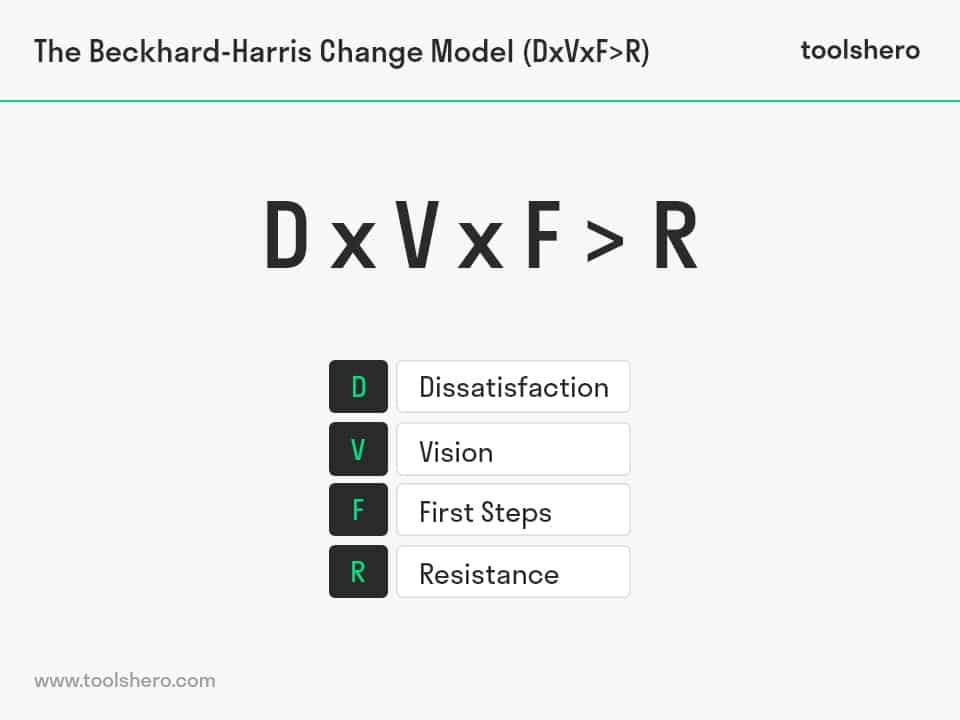Beckhard and Harris Change Model

Beckhard and Harris Change Model: this article provides a practical explanation of Beckhard and Harris’ Model of Change. After reading, you will understand this model of change analysis of organisations in their transformations to achieve the desired success.
What is the Beckhard and Harris Change Model?
The goal of the Beckhard and Harris Change Model is to achieve an analysis of the success or failure of a company’s transition in the changes it makes in the workplace. The analysis is always in favour of the success of the organization. The model helps to overcome resistance that exist between different processes and employees within the company.
Gleicher’s formula for change
The model was initially devised by management consultant David Gleicher in the 1960s, but was further developed years later in 1980 by the theorists Richard Beckhard and Reuben T. Harris. The modification of this model was a formula for change and resistance in organisations, published in his book “Organizational Transitions: Managing Complex Change”.
This method is also known as the Formula of Change or the Model of Change which offers an easy way of simple analysis that controls the potential success of a change initiative in a company.
Steps for the change process in management
It is important to have the steps to achieve the change in an easy way in the company.
1. Internal organizational analysis
This is to identify the attitude towards possible changes in the company. This means identifying the employees who could possibly resist the changes and the external forces that could arise. It is also identifying the pros and cons that might arise from the changes. The company must consider the benefits to be gained from the changes that are to be made.
2. Identifying the need for change
It is important to be clear about where you want to go and why you need to change, connecting the disadvantages you find in the company to include changes that can improve these factors that are negative in order to have new advantages and achieve organizational success.
Compare the current performance of the company with possible changes to be implemented in the future. Make a tangible picture to know what is not working and what is working, to know what the improvements would be with the changes and how these could lead to success, including resistance that at first appears among employees.
3. Conduct a gap analysis
Before making changes, leaders must first determine the flaws or negative factors that are preventing the company from developing its full potential. With their feet on the ground, they must know where the organization stands in order to make the future successful with the changes they wish to implement.
4. Action planning stages
This is where the plan for change is implemented. Identify the key factors or actors for the change process (who will implement the changes and who will be most affected by the changes). For those who will implement the changes, the responsibilities for each change must be identified.
Beckhard and Harris’ Formula for Change
This model also implements a mathematical formula of change, complementing the theory of the model.
The Beckhard and Harris Model of Change considers the factors necessary for change to take place. The Model of Change points out that companies and people change when there is change:
Dissatisfaction (D)
Current dissatisfaction of employees or stakeholders in the organization. This is the main factor for change. It is important to keep in mind that those involved must be motivated in order to make the changes. Take into account their opinions, in order to have a more global perspective of the situations to be changed.
It is inevitable that some will defend their responsibilities and not wish to change, however, this is why it is important to listen to the voice of all employees in order to make the decisions to initiate change.
Vision (V)
Responsibility for the future, this is done by the managers or leaders who are in charge of the changes to be made in the company. Leadership is a fundamental part of the vision of the short and long term changes that will take place in the company, so explaining and accompanying employees in this process is essential for the company. Make it clear why the changes are needed, the responsibilities of those involved and why this is in the best interest of the company.
Reassuring, explaining and supporting employees and those directly involved in the changes is the best way to give way to the vision of organizational change.
First steps (F)
The first steps are the tasks that will be carried out in order to reach the fulfilment of objectives and therefore achieve success. It is necessary for each employee to understand what role he or she will play in the implementation of the changes. The steps must be clear and easy to move forward, so the motivation must be activated to achieve the final goal.
The awareness that must be generated by employees is vital so that the right steps for change can be taken. Employees must be aware that their role is important for the implementation of changes in the present and future of the company.
Resistance (R)
The resistance to change. Most people do not like change or are resistant to changes in the workplace. People usually react to change by becoming afraid, trying to avoid risks, trying to maintain the status quo as it is at the moment, and avoiding change as it deepens into unavoidable oppositional thoughts or actions.
These thoughts or actions can change over time if they are properly accompanied and motivated. Resistance to change is simply the force that must be overcome for the change initiative to succeed.
Does D x V x F > R give quantitative results?
This equation is difficult to assess quantitatively, however, the change formula is the guide to creating a meaningful and efficient change initiative.
The use of surveys, conversations, opinions, among others, is important in order to analyse Resistance to Change and Dissatisfaction. The First Steps and the Vision are the factors that are under the control of the leaders who want to implement change in the company.
This equation is intentionally designed as a multiplication; this means that if any individual factor on the left side, whether Dissatisfaction, Vision or Resistance to Change is zero, the whole left side of the equation is completely equal to zero and the new initiative cannot be implemented. All three factors must have some weight to drive the change process.
The formula suggests that the three components dissatisfaction, vision and the first steps must be present in sufficient quantity to overcome the resistance to change.
Strategies for successful change
Communicating and talking about discomfort
Honesty is an important role in workplace situations.
Sharing strategic visions
These must be clear and already defined. The vision must be disseminated so that all those involved participate in achieving the goals for change.
Impact in the first steps
The first steps towards change must be high-impact in order to empower initiatives and change.
Formula Gleicher version
To understand this, we must understand where Beckhard and Harris’ Model of Change comes from.
C= A x B x D>X
Where:
C is change
A is the status quo of dissatisfaction
B is the clear state desired
X is the cost of change (difficulties, demotivation and risks)
For change to happen, the forces of change must outweigh the perceived costs of change. Factors A, B and D must exceed the costs of change X for the change to occur. An organization must ensure that the change will bring positive results and not waste resources before moving to the next step, which is gap analysis.
GAP Analysis analyses the current state of the organization and identifies how a company wants its future to look. Finally, the organization must plan and manage the change. This equation was the main approach from which Beckhard and Harris restated their model.
The formula was later popularised by Kathleen Dannemiller who dusted off the formula and simplified it, making it more accessible to consultants and managers. Dannemiller and Robert W. Jacobs first published the most common version of the formula in 1992.
This is how Gleicher started the methodology, then Beckhard and Harris promoted it, but it really took off when Dannemiller updated the formula for change. Made more simplified in 1992, this formula is famous in today’s organizations for the changes that companies need to present in order to achieve objectives and thus be successful.
Dannemiller Formula
P x V x F x CL > R
D represented dissatisfaction with current conditions, V for the vision of what things could be like, F for (first) practical steps towards change, and CL for creative leadership to make the process work. All these elements multiplied had to overcome R, standing for resistance, for change to take place and be long lasting.
This formula is managed in the human resources category because the importance of motivation of the people involved and the personalities are important to make changes in the organization and also the acceptance of these changes for the improvements.
Discussion on changes
Changes are always to improve organizational factors that are not working well in a company, however, these changes can open discussions or resistance among the people involved. Having a foundation of trust, motivation and confidence in employees is a vital factor in making the changes that will lead to business success.
Human resources are the base area for these changes. Many people discuss the adaptation of changes, some say that the change must be made without taking into account the working staff, since no one is indispensable for the management of the processes, but others defend that the adaptation of changes must be analysed, communicated and worked hand in hand with those involved so that everything is a success despite the difficulties of resistance found at the beginning.
With this formula it will be possible to have a more exact vision of the changes and how they will weigh in the short, medium and long term in the company, always with the objective of achieving organizational success.
Now it’s your turn
What do you think? Is it important to have the formula for change for companies today? Have you implemented the Beckhard and Harris Change Model? If so, how has it worked for you? Do you have anything else to add?
Share your experience and knowledge in the comments box below.
More information
- Harris, R. T., & Beckhard, R. (1987). Organizational transitions: Managing complex change. Reading, Mass.: Addison-Wesley Publishing Company.
- Mansell, J., McGill, P., & Emerson, E. (2001). Development and evaluation of innovative residential services for people with severe intellectual disability and serious challenging behavior. In International review of research in mental retardation (Vol. 24, pp. 245-298). Academic Press.
- Nadler, D. A. (1993). Concepts for the management of organizational change. Managing change, 2, 85-98.
How to cite this article:
Ospina Avendano,D.(2020). Beckhard and Harris Change Model. Retrieved [insert date] from Toolshero: https://www.toolshero.com/change-management/beckhard-harris-change-model/
Published on: 13/11/2020 | Last update: 18/02/2022
Add a link to this page on your website:
<a href=”https://www.toolshero.com/change-management/beckhard-harris-change-model/”>Toolshero: Beckhard and Harris Change Model</a>













